Sourdough bread, known for its thick, chewy crust and soft, airy interior, is a classic example of traditional baking’s simple elegance. Made with just flour, salt, and water, sourdough has surged in popularity the last few years, attracting beginner and seasoned bakers alike! The key to its distinctive taste and texture lies in the sourdough starter, a fermented mixture that naturally leavens the bread. This guide simplifies the process of creating and maintaining your own starter, and it teaches you how to bake your own sourdough loaf.
If you love homemade bread, you absolutely need to try homemade French bread, cinnamon swirl bread, and this easy sandwich bread.
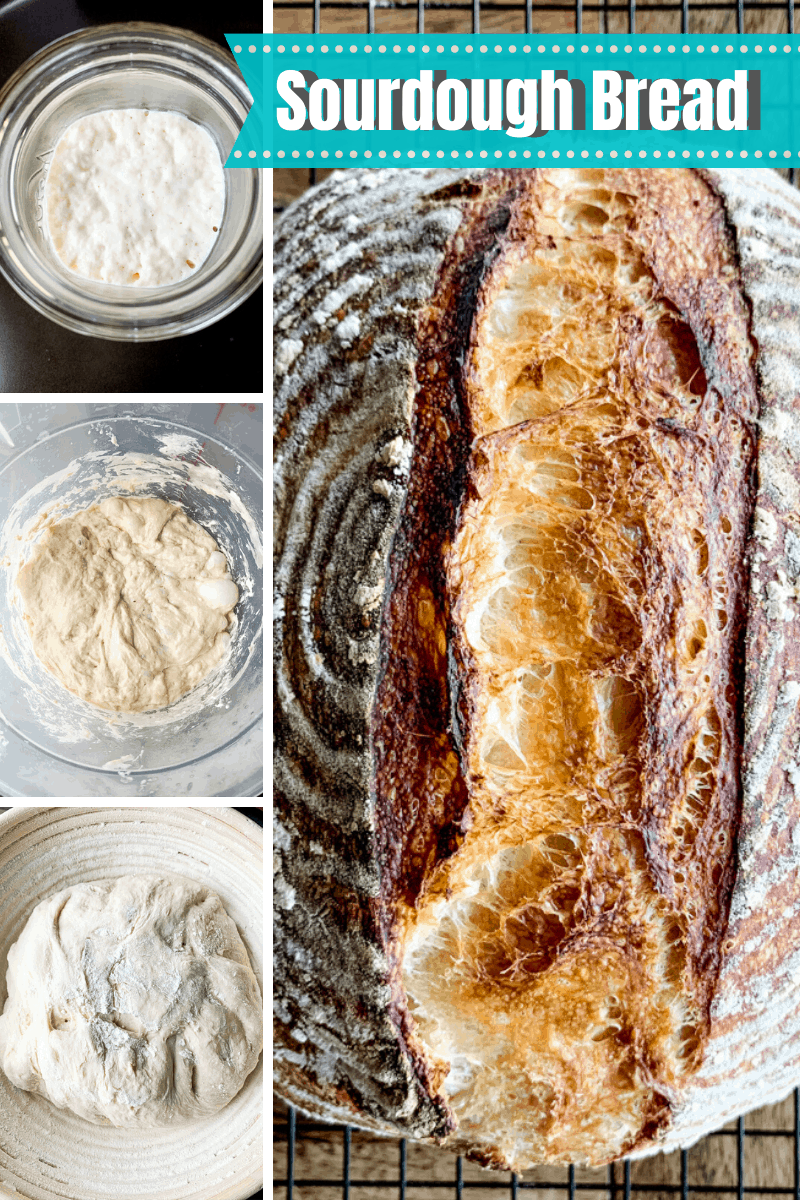
Sourdough Bread Recipe
We know many people are looking for an easy introduction to sourdough, without worrying about technique, so consider this your introductory lesson to making sourdough starter and bread from scratch. There are many methods and recipes for sourdough out there, and we are just focusing on one simple method. If you graduate from this and want to get fancy, there is a lot more to try out with sourdough baking!
The most important first step is to have a sourdough starter. You might already know someone with a starter, and if so, you’ve got an easy head start! You don’t need a lot, just get a couple of tablespoons and then immediately feed. If you aren’t lucky enough to have family or friends with an active sourdough starter, you can make your own from flour, water, and a bit of patience.
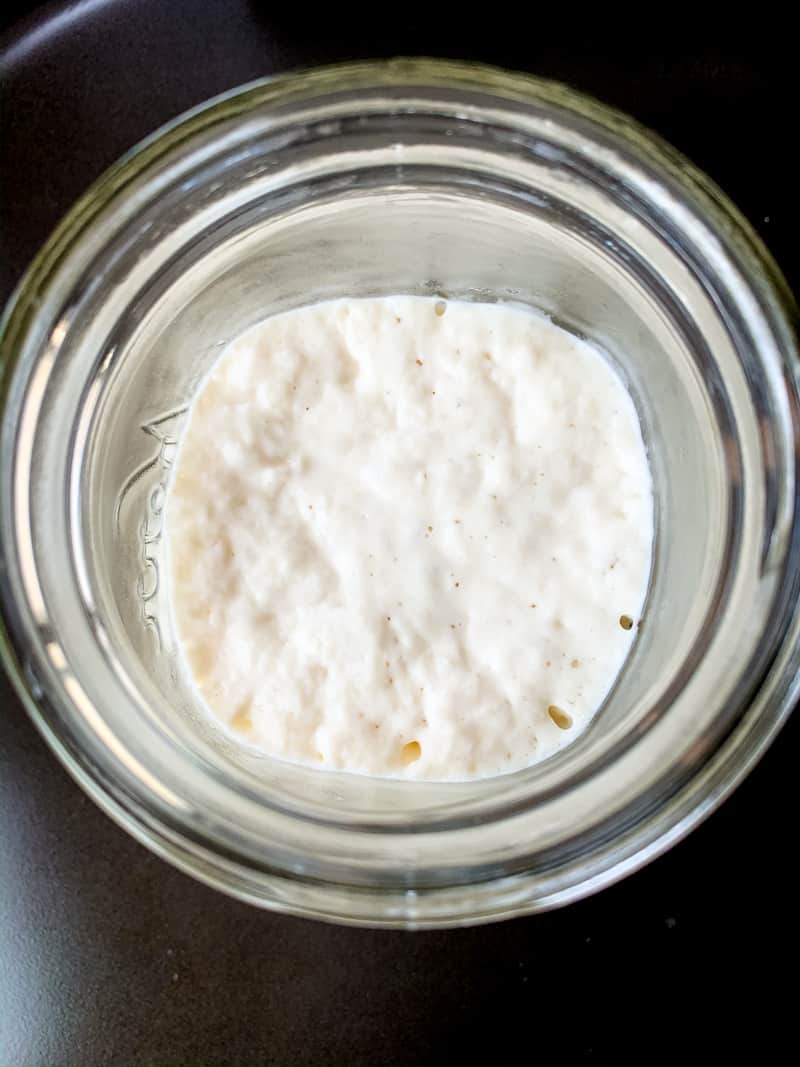
How to Make Your Own Sourdough Starter:
Wild yeast lives in the air and flour, it’s everywhere really! Breads made from wild yeast do not require commercial yeast. To make your own wild yeast sourdough starter
- Fill a larger plastic or glass container with 1/2 cup flour and 1/2 cup water. Stir until thoroughly combined into a smooth batter.
- Cover with a loosely screwed on lid or plastic wrap.
- “Feed” your starter 4 ounces of water and flour, stirring until combined, every 24 hours.
- Notice any air bubbles day to day, both large and small, that means it’s working and the wild yeasts are doubling! It should start to smell sour after a few days, but room temperature can affect how quickly it activates. Don’t worry too much about it, just keep feeding it every day. The texture will change from a pancake dough batter to an airy, lighter batter over the first 5 days.
- By day 5, or once it smells sour and is airy and doubling in volume, it is ready to use in your preferred sourdough bread recipe!
How to Maintain a Sourdough Starter
If you bake bread often, you can leave your starter on the counter and feed daily to keep it active. We like to feed 5 Tablespoons of both flour and water. You’ll find that your jar can’t contain that much starter, as it will double in size each time you feed it. You can either discard a bit of starter before each feed, or you can save it and use in waffles, pancakes, pizza dough, or even fry up that discarded starter in oil and add some seasonings as a delicious, sourdough ‘pancake!’ Just always make sure to leave at least 2 tablespoons of starter behind to continue to feed. You never want to use it all up.
If you want to only make bread once each week or less, keep your starter stored in the fridge. 2 days before you’re ready to make bread, remove it from the fridge and feed and leave on the counter. 24 hours later, feed it again. It could take anywhere from 2-5 hours for the starter to be fully active and ready to use after that second feed. Once it is fully active and doubled in size, you are ready to bake. Make sure to feed your starter after each discard or use.
Using Your Sourdough Starter: Making the Dough
Now that your starter has doubled in size and is billowing at the top, you are ready to make your bread dough. We like a larger loaf, so mix 5 cups of flour with 2 cups of water. Either all purpose or bread flour will work, though we prefer bread flour. You can start mixing with a wooden spoon if you like, but you’ll realize pretty quickly that a spoon will only get you so far, and you’ll want to switch to just mixing by hand. The dough will be really sticky and thick. Let the dough rest for 45 minutes with a lid on or covered in plastic wrap. This resting process where gluten development begins is called the autolyse.
First Rise
After 45 minutes, add in 1 Tablespoon salt and 1/2 cup of your starter to the water/flour mixture. Mix this all in by hand until well combined, but do not knead. Let it rise for anywhere from 12-24 hours. In the winter, when the house is cooler, we let this rise for about 20 hours. In the summer, we stick fairly close to 12-14 hours. You just want it to double in size. Without adding any commercial yeast, this can be a fairly long process, so we tend to do this first rise overnight.
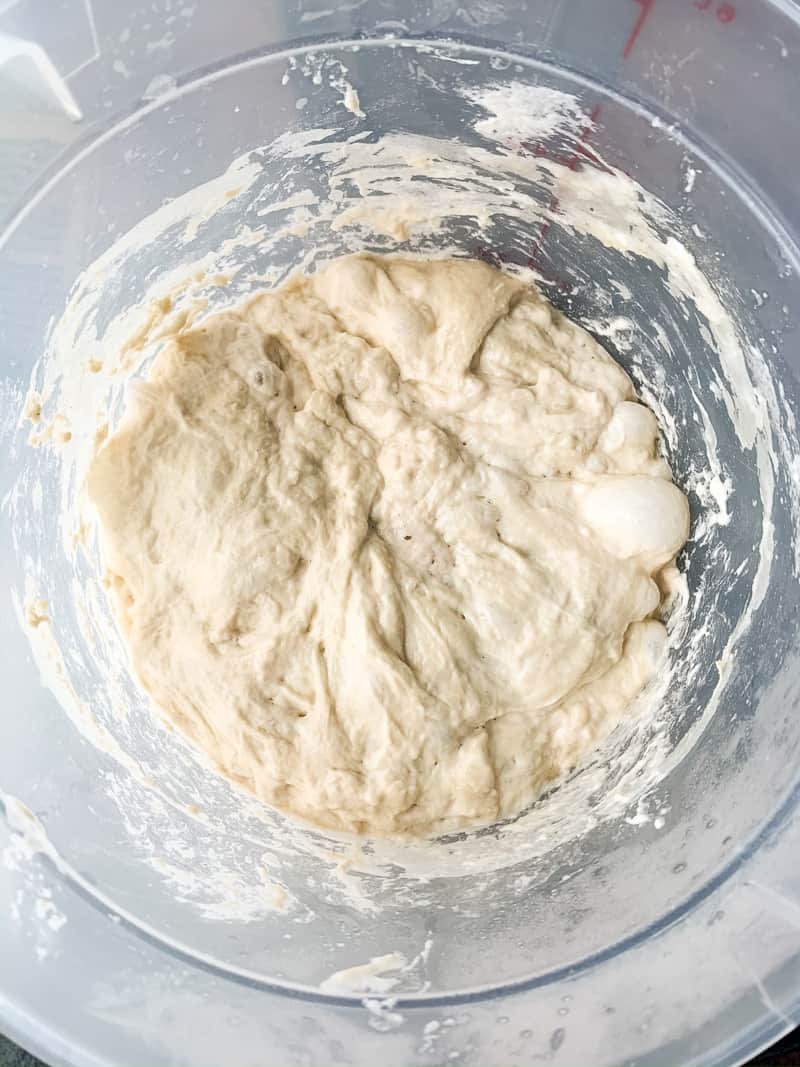
Second Rise
Once the dough has doubled in size, dump it out onto a clean, floured surface and fold it over a few times into the center. Transfer this to an oiled bowl or to a floured proofing basket. Let it rise for 3-5 hours. You’ll know it’s ready when you poke it with your finger (not too harshly) and the indent remains, or only very slowly springs back while still leaving an indent. If the dough springs right back, it needs more time to rise.
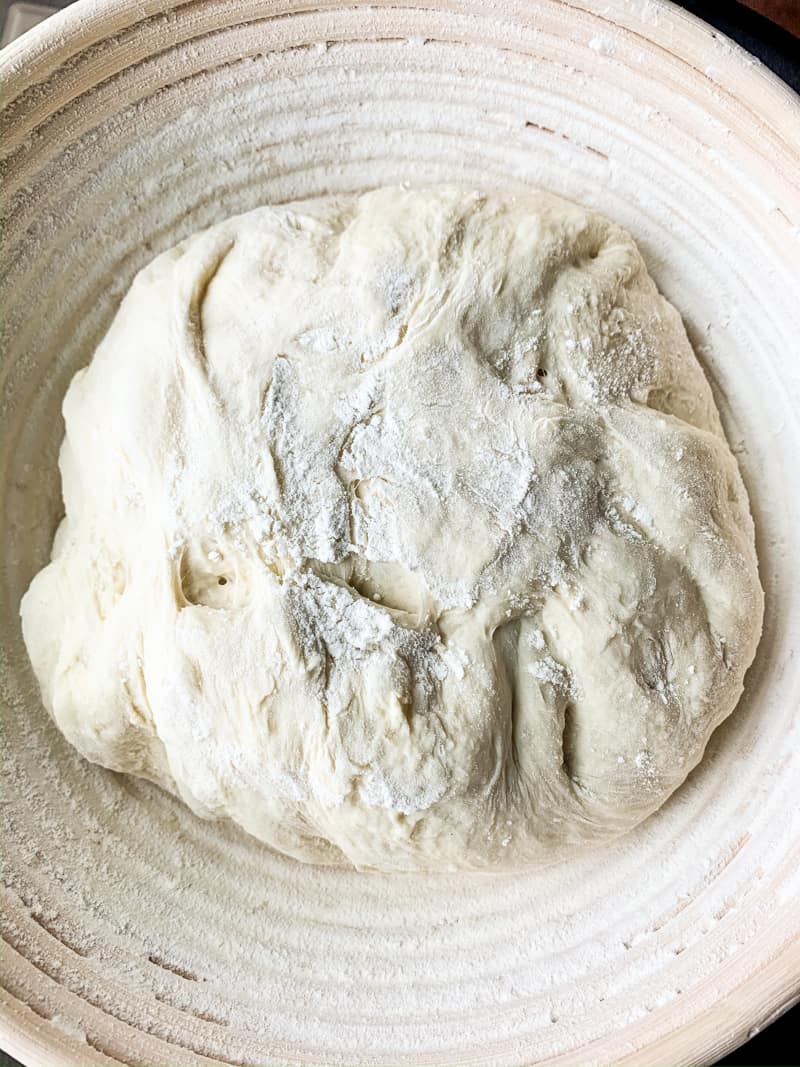
Baking Sourdough Bread
Once your dough is fully risen, preheat your oven to 450 degrees Fahrenheit with your dutch oven in the oven for the entire preheating time. Flip your dough from your basket/bowl onto a bread sling or large piece of parchment paper. Use that excess parchment paper to help lift the dough into the dutch oven. Put lid on and bake for 30 minutes. After 30 minutes, remove the lid and continue to bake until bread is a deep brown, approximately 30 more minutes.
PRO TIP: Put a baking sheet under your dutch oven when you remove the lid, and bake for the remaining time this way. This will ensure the bottom of the bread doesn’t get too dark or burn.
Once the bread is a deep brown, turn off oven and crack the door. Let your bread cool in the cracked oven for 20 minutes before removing from oven and dutch oven, and putting on a cooling rack. Cutting into a warm loaf of bread is SO tempting, but it is important to let the bread cool completely to allow texture and flavor to develop completely.
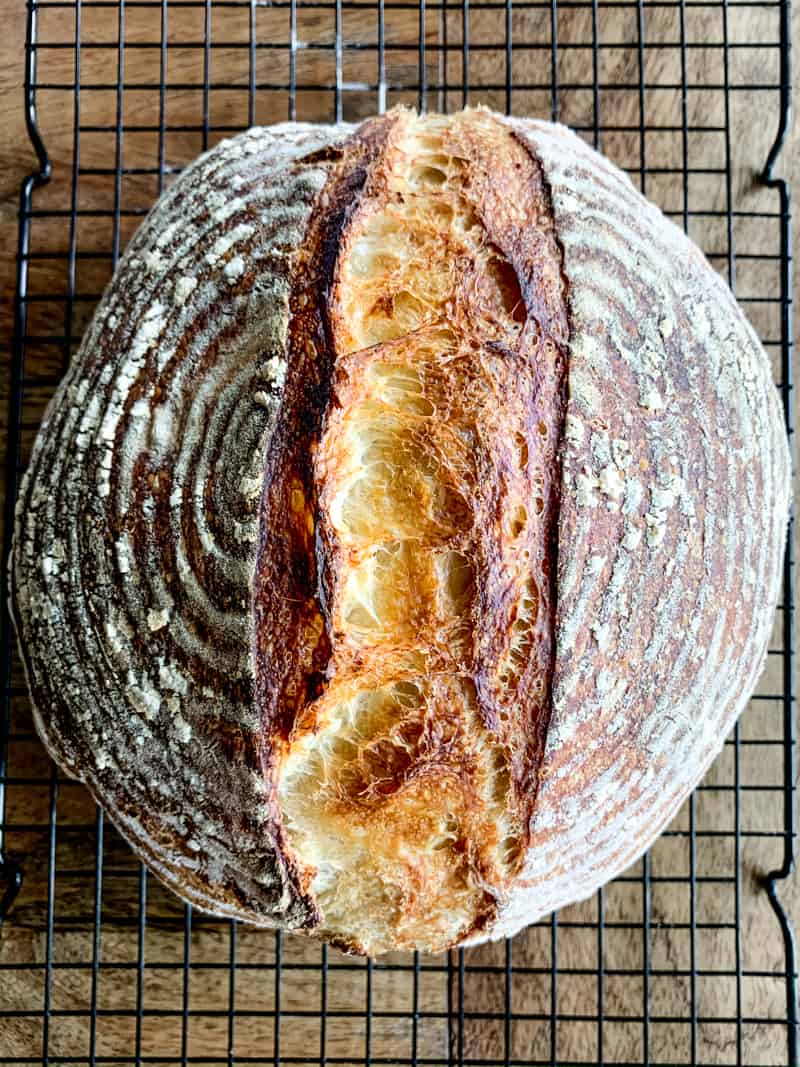
Storage Instructions for Sourdough Bread
Room Temperature Storage:
- Cool the bread completely before storing.
- Wrap the bread in a clean, dry cloth or place it in a paper bag to maintain its crust’s texture.
- Store in a cool, dry place for up to 3 days.
Refrigerator Storage:
- Not recommended, as it can dry out the bread and affect texture.
Freezer Instructions for Sourdough:
- Slice the bread if desired for easier use.
- Wrap slices or whole loaves tightly in plastic wrap or aluminum foil.
- Place wrapped bread in a freezer bag or airtight container.
- Label the bag or container with the date.
- Freeze for up to 3 months.
To Thaw:
- Leave at room temperature, wrapped, until thawed. For slices, you can toast directly from frozen for convenience.


Do I need to split the loaf before cooking? The picture looks like it was split down the middle.
Splitting is not necessary, but you can! This loaf was split, but it takes an extremely sharp knife or blade to be able to split well. Half of the time, we don’t even bother.
Love your recipe’s! Keep them coming!! Thanks soo much!
I’m guessing I can’t use gluten free all purpose flour for this recipe?
We recommend finding a recipe meant for gluten free baking. Simple substitutions for gluten free flour typically do not work well.
I’m so excited to do this. Can I use whole wheat flour?
You can substitute (at most) half of the flour with whole wheat.
What size dutch oven do you recommend?
a 5 or 6 quart should do!
Hi Rachel, Can you please confirm what the size is of the Dutch oven you are using in this recipe? Thanks!
Unfortunately, this is a very old dutch oven without a size stamped on the bottom! I have compared it to other dutch ovens I own and assume it is roughly a 5 quart.
Hi Rachel
Using the parchment paper to lift the dough into the Dutch oven do you simply lower the paper and leave it there for the baking process? Does that also help in removing the loaf from the pan when done?
Thanks and I love your Stay At Home Chef recipes.
Jim in Austin
Yes, you want to lower the paper in (carefully, because the pan will be hot) and leave it in for the baking process. Lifting it out isn’t as easy. It’s better to tip it upside down with one hand and catch with the other (use pot holders please!). I even reuse this single sheet of parchment many times over for new loves of bread.
Hi, Rachel! I have been wanting to get started making sourdough for quite a while so I appreciate you sharing this recipe!!
I do have one question, if I keep the starter in the fridge, how often will I need to feed it? I understood the recipe to mean that I can make the starter, get it active, then store it in the fridge until two days before baking. So that would mean I don’t have to feed it while it’s in the fridge, just when I take it out to bake with it.
Thanks so much!! Love your recipes!! ?
Emily
If you keep the starter in the fridge, and you don’t regularly make bread, I recommend feeding it once/week still. Otherwise, if you’re going to be making bread once/week, you can just feed 2 days before making bread every week.
Awesome, thanks!!
Can you make this recipe without a Dutch oven??
Thank you!
Jane
All you really need is an oven safe pot with a lid.
I can’t wait to make this! Question:. Us it 4oz of water AND 4oz of flour? (how much is 4oz of flour ?)? Thank you!
Yes, when you feed you want to use equal amounts of flour and water. In this initial bulking up and making your starter phase, you want to feed 4 ounces of both flour and water. 4 ounces is also equal to 8 Tablespoons. If you prefer weighing in metric, this is equal to 113 grams.